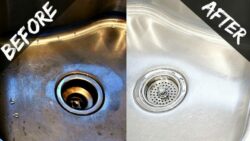Maintaining the pristine and immaculate appearance of a white sink can be a challenging task, but fear not, as this ultimate guide is here to provide you with effective ways to conquer this cleaning endeavor. With the use of simple yet powerful techniques, you will learn how to restore your white sink to its original gleaming condition. Whether you are dealing with stubborn stains, mineral build-up, or dullness, these methods will equip you with the expertise needed to keep your white sink looking stunningly clean.
Preventive Measures
Avoiding Staining
When it comes to maintaining the cleanliness and appearance of your white sink, prevention is key. To avoid staining, it is important to be mindful of what comes into contact with your sink. Be cautious when using strong dyes, food coloring, or any chemicals that could potentially cause discoloration. Additionally, try to avoid leaving items such as wet sponges, metal utensils, or rusting objects in the sink for extended periods of time, as these can also lead to unsightly stains.
Regular Maintenance
Regular maintenance is crucial in keeping your white sink looking pristine. By implementing a consistent cleaning routine, you can prevent stubborn stains from building up and ensure that your sink stays in optimal condition. Daily cleaning, weekly maintenance, and periodic deep cleaning methods can all contribute to preserving the shine and luster of your white sink.
Daily Cleaning Tips
Using Gentle Cleansers
One of the most effective ways to clean a white sink on a daily basis is by using gentle cleansers. Regular dish soap, combined with warm water, can be used to gently scrub the surface of the sink. Avoid using abrasive cleaners or rough sponges, as they can scratch and damage the sink’s finish.
Using Baking Soda
Baking soda is a versatile and natural cleaning agent that can be utilized to remove stains and odors from your white sink. Create a paste by mixing baking soda with water, and then apply it to the stained areas of your sink. Let it sit for a few minutes before scrubbing gently with a soft brush or sponge. Rinse thoroughly with water to reveal a refreshed and stain-free sink.
Cleaning with Vinegar
Vinegar is another effective and natural cleaning solution for white sinks. To use vinegar as a cleaning agent, pour it directly onto a sponge or cloth and wipe down the sink’s surface. For tougher stains, you can create a vinegar spray by combining equal parts vinegar and water in a spray bottle. Spray the mixture onto the stained areas, let it sit for a few minutes, and then wipe clean with a cloth or sponge.
Rinsing Thoroughly
After using any cleaning solution or method, it is important to rinse your white sink thoroughly. Leftover residue from cleaning agents can potentially damage the sink’s surface or leave behind unwanted streaks and stains. Ensure all traces of cleaning products are washed away with water, and dry the sink with a clean towel to prevent water spots.
Weekly Cleaning Routine
Removing Stains
Regardless of how careful you are, stains can still occur in a white sink. To remove these stubborn stains, there are several methods you can try. For organic stains, such as food or beverage spills, a mixture of hydrogen peroxide and baking soda can be effective. Apply the paste to the stained area, let it sit for a few minutes, and then scrub gently with a soft brush before rinsing thoroughly.
Scrubbing with a Soft Brush
Using a soft brush is an essential tool for maintaining the cleanliness of a white sink. It allows you to scrub away grime and residue without scratching or damaging the sink’s surface. Be sure to choose a brush specifically designed for cleaning sinks, as it will typically have softer bristles that are gentle enough to prevent any potential damage.
Applying Stain Removers
If traditional cleaning methods and gentle cleansers do not effectively remove stains from your white sink, you may need to turn to specialized stain removers. There are several products available on the market that are tailored specifically for removing stubborn stains from sinks. Follow the manufacturer’s instructions carefully when applying these stain removers to ensure maximum effectiveness.
Deep Cleaning Methods
Using a Bleach Solution
For deep cleaning a white sink and removing tough stains, a bleach solution can be highly effective. Create a mixture of one part bleach to five parts water, and use a sponge or cloth to apply the solution to the stained areas. Let it sit for a few minutes before rinsing thoroughly with water. It is important to exercise caution when working with bleach, as it can be harsh and should be handled in a well-ventilated area.
Using Hydrogen Peroxide
Hydrogen peroxide is a versatile cleaning agent that can be used for deep cleaning a white sink. It is particularly effective in removing tough stains, such as those caused by coffee or tea. Apply hydrogen peroxide directly to the stained areas, let it sit for a few minutes, and then scrub gently with a soft brush or sponge. Rinse thoroughly to reveal a clean and stain-free sink.
Removing Rust Stains
If your white sink has become stained with rust marks, there are ways to alleviate this issue. One method involves creating a paste with lemon juice and salt and applying it to the rust stains. Let it sit for a few minutes before scrubbing gently with a soft brush. Another option is to use a commercial rust remover specifically designed for sinks. Follow the instructions on the product carefully to effectively remove the rust stains.
Polishing with a Non-abrasive Cleaner
After deep cleaning your white sink, it is important to restore its shine and luster. A non-abrasive cleaner can help achieve this. Apply a small amount of the cleaner to a soft cloth, and gently buff the sink’s surface. This will remove any remaining residue and leave the sink looking polished and clean.
Cleaning Sink Fixtures
Removing Mineral Deposits
Over time, mineral deposits can build up on your sink fixtures, causing them to appear dull and discolored. To remove these deposits, soak a cloth or paper towel in vinegar, and wrap it around the affected area. Let it sit for several hours or overnight to dissolve the mineral deposits. Afterward, rinse the fixtures with water and wipe them dry to restore their shine.
Cleaning Faucets and Handles
Faucets and handles are often areas that accumulate dirt, grime, and bacteria. To keep them clean, it is important to regularly wipe them down with a gentle cleanser. Use a soft cloth or sponge to gently scrub the surfaces, paying attention to any crevices or hard-to-reach areas. Dry the fixtures thoroughly to prevent any water spots or streaks from forming.
Maintaining Shine and Luster
Using Lemon Juice
Lemon juice is a natural cleaning agent that can effectively remove stains and restore shine to your white sink. To utilize lemon juice for this purpose, cut a lemon in half and rub it directly onto the stained areas of your sink. Let the juice sit for a few minutes before scrubbing gently with a soft brush or sponge. Rinse thoroughly to reveal a sparkling and refreshed sink.
Applying a Sink Wax
To protect your white sink and maintain its shine, applying sink wax can be beneficial. Sink wax creates a protective layer that helps guard against stains and makes it easier to clean your sink. Follow the manufacturer’s instructions on how to apply the wax, and ensure that the sink is completely dry before proceeding.
Buffing for Shine
After cleaning and applying any necessary treatments, it is important to buff your white sink for that extra shine. Using a clean, soft cloth, gently buff the sink’s surface in circular motions. This will help remove any remaining residue, enhance the sink’s shine, and leave it looking polished and immaculate.
Tackling Tough Stains
Removing Grease and Oil Stains
Grease and oil stains can be particularly stubborn to remove from a white sink. To tackle these stains, mix a small amount of dish soap with hot water and apply it directly to the affected areas. Let the soapy solution sit for a few minutes before scrubbing gently with a soft brush or sponge. Rinse thoroughly with water to reveal a clean and grease-free sink.
Dealing with Coffee and Tea Stains
Coffee and tea stains are a common occurrence in white sinks. To remove these stains, begin by rinsing the stained area with hot water to loosen the residue. Then, create a paste by mixing baking soda with water, and apply it to the stains. Scrub gently with a soft brush or sponge, paying close attention to the edges of the stains. Rinse thoroughly to reveal a stain-free sink.
Eliminating Hard Water Stains
Hard water stains can leave unsightly marks on your white sink. To eliminate these stains, create a mixture of equal parts vinegar and water. Dip a cloth or sponge into the solution and gently scrub the stained areas. Let it sit for a few minutes before rinsing thoroughly with water, and dry the sink to prevent water spots. If the stains persist, repeat the process or consider using a commercial hard water stain remover.
Preventing Scratches and Damage
Using a Sink Protector
To prevent scratches and damage to your white sink, consider using a sink protector. These protective grids or mats can be placed in the bottom of the sink to shield it from heavy pots, pans, and utensils. The sink protector acts as a cushion, reducing the risk of accidental scratches and dents that can mar the sink’s appearance.
Avoiding Abrasive Scrubbers
It is important to avoid using abrasive scrubbers when cleaning a white sink, as they can cause scratches and damage to the sink’s finish. Opt for soft brushes, sponges, or microfiber cloths when scrubbing the sink’s surface. Additionally, avoid using metal scouring pads or harsh cleaning chemicals that can be abrasive to the sink’s material.
Dealing with Discoloration
Removing Yellowing or Discoloration
Over time, white sinks can develop yellowing or discoloration due to a variety of factors. To remove yellowing or discoloration, create a paste with baking soda and water. Apply the paste to the affected areas and let it sit for several hours, or overnight if possible. Scrub gently with a soft brush or sponge and rinse thoroughly with water. Repeat the process if necessary to restore the sink’s original white appearance.
Restoring a White Sink
If your white sink has become severely discolored or stained, there are options available to restore its original white appearance. Consider using a sink refinishing kit specially designed for white sinks. These kits typically include a refinishing solution that can help repair and revitalize your sink’s surface. Follow the instructions carefully and exercise caution when working with these products.
Hiring Professional Help
When to Consider Professional Cleaning
If your white sink has extensive stains, discoloration, or damage that cannot be effectively addressed through regular cleaning methods, it may be time to enlist the help of professional cleaners. Professional cleaning services can provide specialized expertise and equipment to restore your sink to its best possible condition. Additionally, if you are short on time or prefer to leave the cleaning in the hands of experts, hiring professionals can save you time and effort.
Choosing a Reliable Service
When hiring professional help to clean your white sink, it is important to choose a reliable and reputable service. Look for companies that have experience and a proven track record in handling delicate surfaces, such as white sinks. Read customer reviews, ask for recommendations from friends or family, and request a quote to ensure that you are getting the best service for your needs and budget.
By implementing these effective cleaning methods and preventive measures, you can keep your white sink looking pristine and beautiful for years to come. Regular maintenance, daily cleaning routines, and periodic deep cleaning will help preserve the shine and luster of your sink, ensuring a clean and inviting kitchen or bathroom. Remember to choose cleaning products and tools that are gentle yet effective, and always exercise caution when using chemicals. With proper care, your white sink will continue to be a focal point of cleanliness and elegance in your home.





